�
NANO/MICROSCALE
HEAT TRANSFER
ABOUT THE AUTHOR
Zhuomin M. Zhang has taught at the University of Florida (1995–2002) and the
Georgia Institute of Technology (since 2002). Professor Zhang is an ASME
Fellow and has done cutting-edge research in the areas of micro/nanoscale heat
transfer, with applications to optoelectronic devices and semiconductor manu-
facturing. He is a recipient of the Presidential Early Career Award for Scientists
and Engineers (PECASE), the ASME Heat Transfer Division Best Paper Award,
and the AIAA Thermophysics Best Paper Award. Professor Zhang currently
serves on the Editorial Board of the International Journal of Thermophysics and
is an associate editor for the Journal of Quantitative Spectroscopy & Radiative
Transfer and the Journal of Thermophysics and Heat Transfer.
Copyright © 2007 by The McGraw-Hill Companies, Inc. Click here for terms of use.
�
NANO/MICROSCALE
HEAT TRANSFER
Zhuomin M. Zhang
Georgia Institute of Technology
Atlanta, Georgia
New York Chicago San Francisco Lisbon London Madrid
Mexico City Milan New Delhi San Juan Seoul
Singapore Sydney Toronto
�
Copyright © 2007 by The McGraw-Hill Companies, Inc. All rights reserved. Manufactured in the
United States of America. Except as permitted under the United States Copyright Act of 1976, no part
of this publication may be reproduced or distributed in any form or by any means, or stored in a data-
base or retrieval system, without the prior written permission of the publisher.
0-07-150973-9
The material in this eBook also appears in the print version of this title: 0-07-143674-X.
All trademarks are trademarks of their respective owners. Rather than put a trademark symbol after
every occurrence of a trademarked name, we use names in an editorial fashion only, and to the bene-
fit of the trademark owner, with no intention of infringement of the trademark. Where such designa-
tions appear in this book, they have been printed with initial caps.
McGraw-Hill eBooks are available at special quantity discounts to use as premiums and sales promo-
tions, or for use in corporate training programs. For more information, please contact George Hoare,
Special Sales, at george_hoare@mcgraw-hill.com or (212) 904-4069.
TERMS OF USE
This is a copyrighted work and The McGraw-Hill Companies, Inc. (“McGraw-Hill”) and its licensors
reserve all rights in and to the work. Use of this work is subject to these terms. Except as permitted
under the Copyright Act of 1976 and the right to store and retrieve one copy of the work, you may not
decompile, disassemble, reverse engineer, reproduce, modify, create derivative works based upon,
transmit, distribute, disseminate, sell, publish or sublicense the work or any part of it without
McGraw-Hill’s prior consent. You may use the work for your own noncommercial and personal use;
any other use of the work is strictly prohibited. Your right to use the work may be terminated if you
fail to comply with these terms.
THE WORK IS PROVIDED “AS IS.” McGRAW-HILL AND ITS LICENSORS MAKE NO
GUARANTEES OR WARRANTIES AS TO THE ACCURACY, ADEQUACY OR COMPLETE-
NESS OF OR RESULTS TO BE OBTAINED FROM USING THE WORK, INCLUDING ANY
INFORMATION THAT CAN BE ACCESSED THROUGH THE WORK VIA HYPERLINK OR
OTHERWISE, AND EXPRESSLY DISCLAIM ANY WARRANTY, EXPRESS OR IMPLIED,
INCLUDING BUT NOT LIMITED TO IMPLIED WARRANTIES OF MERCHANTABILITY OR
FITNESS FOR A PARTICULAR PURPOSE. McGraw-Hill and its licensors do not warrant or
guarantee that the functions contained in the work will meet your requirements or that its operation
will be uninterrupted or error free. Neither McGraw-Hill nor its licensors shall be liable to you or
anyone else for any inaccuracy, error or omission, regardless of cause, in the work or for any damages
resulting therefrom. McGraw-Hill has no responsibility for the content of any information accessed
through the work. Under no circumstances shall McGraw-Hill and/or its licensors be liable for any
indirect, incidental, special, punitive, consequential or similar damages that result from the use of or
inability to use the work, even if any of them has been advised of the possibility of such damages. This
limitation of liability shall apply to any claim or cause whatsoever whether such claim or cause
arises in contract, tort or otherwise.
DOI: 10.1036/007143674X
�
To my wife Lingyun
�
This page intentionally left blank
�
For more information about this title, click here
CONTENTS
Preface
List of Symbols
xiii
xvii
Chapter 1. Introduction
1
1.1 Limitations of the Macroscopic Formulation / 2
1.2 The Length Scales / 3
1.3 From Ancient Philosophy to Contemporary Technologies / 5
1.3.1 Microelectronics and Information Technology / 6
1.3.2 Lasers, Optoelectronics, and Nanophotonics / 8
1.3.3 Microfabrication and Nanofabrication / 10
1.3.4 Probing and Manipulation of Small Structures / 12
1.3.5 Energy Conversion Devices / 15
1.3.6 Biomolecule Imaging and Molecular Electronics / 17
1.4 Objectives and Organization of This Book / 19
References / 22
Chapter 2. Overview of Macroscopic Thermal Sciences
25
2.1 Fundamentals of Thermodynamics / 25
2.1.1 The First Law of Thermodynamics / 26
2.1.2 Thermodynamic Equilibrium and the Second Law / 27
2.1.3 The Third Law of Thermodynamics / 31
2.2 Thermodynamic Functions and Properties / 32
2.2.1 Thermodynamic Relations / 32
2.2.2 The Gibbs Phase Rule / 34
2.2.3 Specific Heats / 36
2.3 Ideal Gas and Ideal Incompressible Models / 38
2.3.1 The Ideal Gas / 38
2.3.2 Incompressible Solids and Liquids / 40
2.4 Heat Transfer Basics / 41
2.4.1 Conduction / 42
2.4.2 Convection / 44
2.4.3 Radiation / 46
2.5 Summary / 51
References / 51
Problems / 52
Chapter 3. Elements of Statistical Thermodynamics
and Quantum Theory
57
3.1 Statistical Mechanics of Independent Particles / 58
3.1.1 Macrostates versus Microstates / 59
3.1.2 Phase Space / 59
vii
�
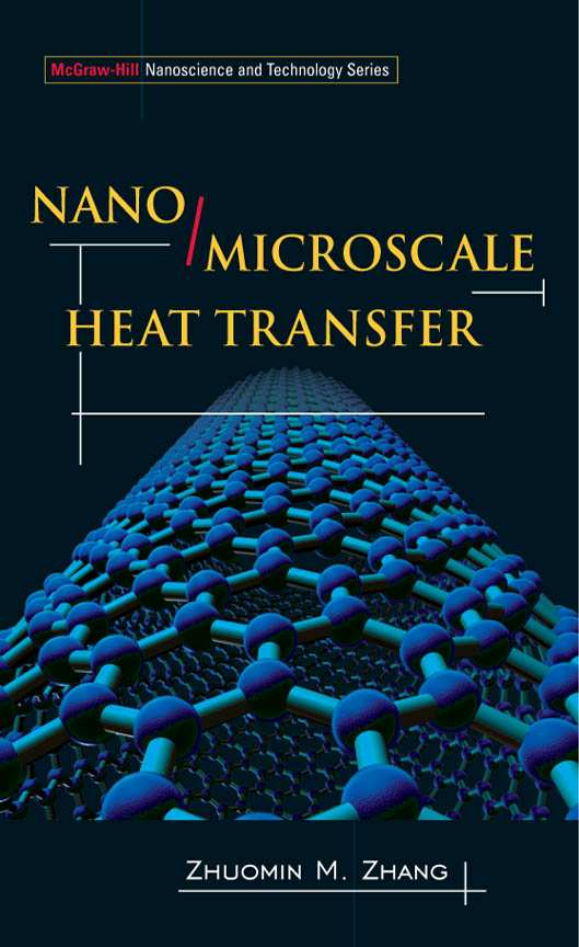
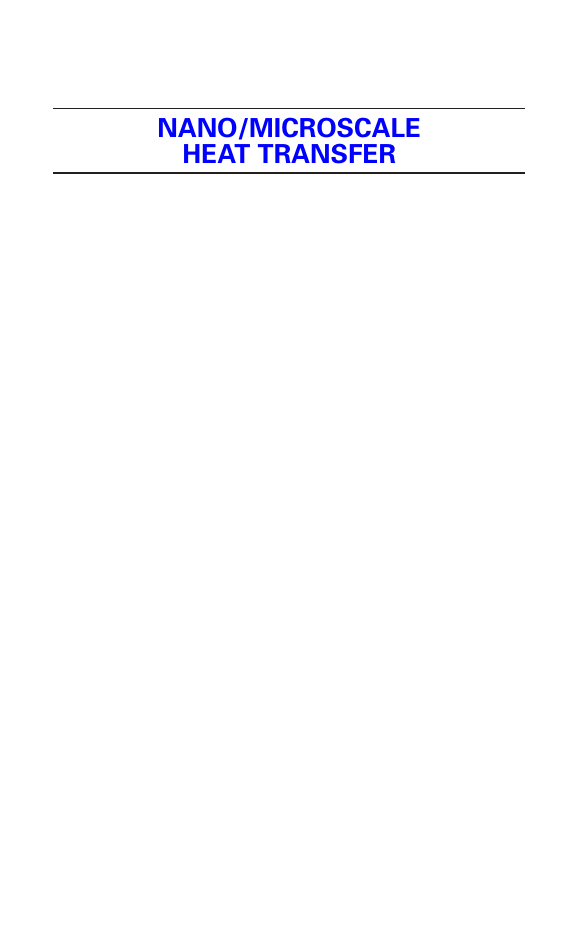
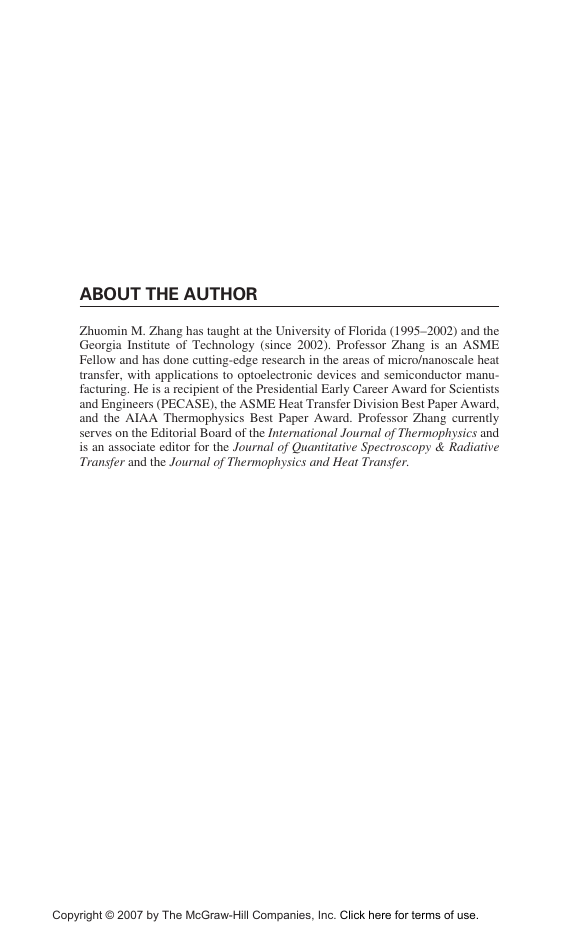
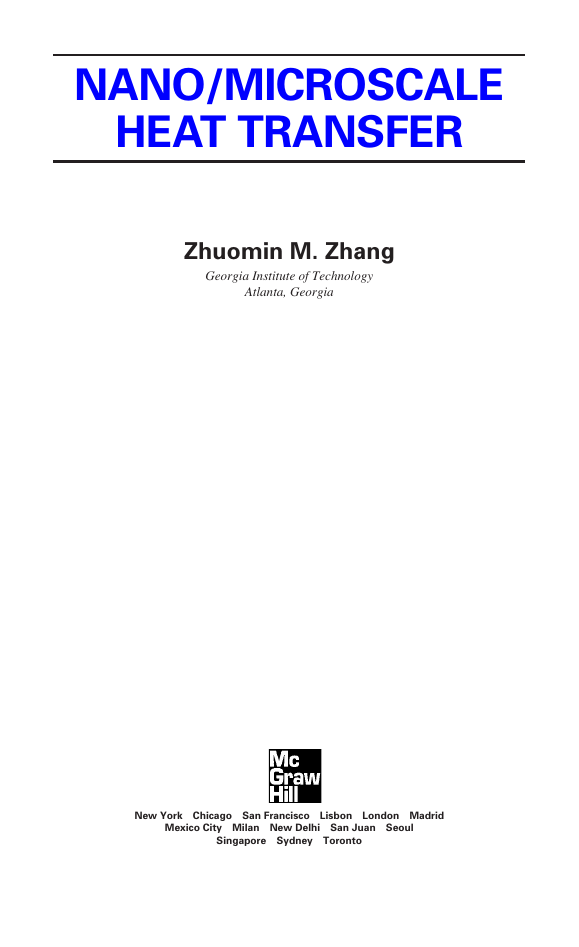



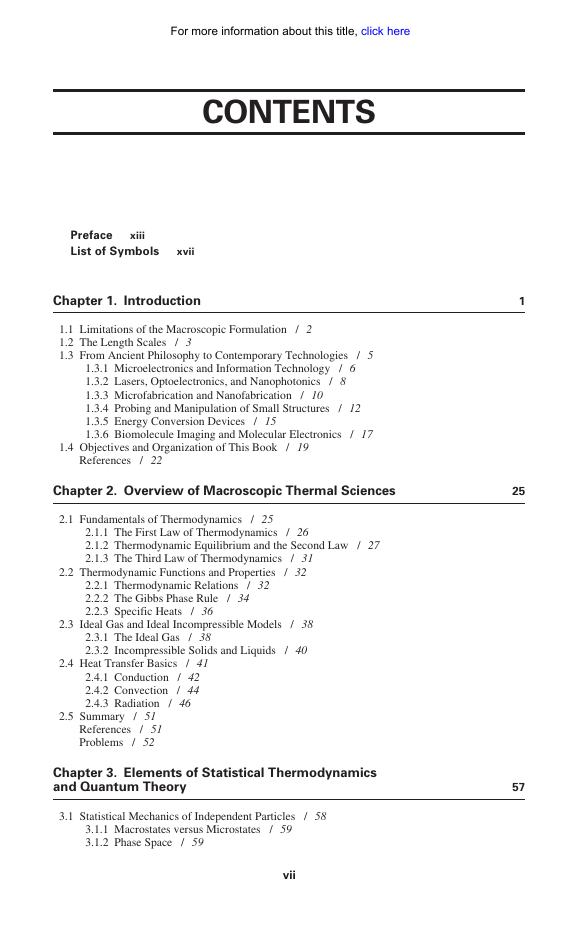








 2023年江西萍乡中考道德与法治真题及答案.doc
2023年江西萍乡中考道德与法治真题及答案.doc 2012年重庆南川中考生物真题及答案.doc
2012年重庆南川中考生物真题及答案.doc 2013年江西师范大学地理学综合及文艺理论基础考研真题.doc
2013年江西师范大学地理学综合及文艺理论基础考研真题.doc 2020年四川甘孜小升初语文真题及答案I卷.doc
2020年四川甘孜小升初语文真题及答案I卷.doc 2020年注册岩土工程师专业基础考试真题及答案.doc
2020年注册岩土工程师专业基础考试真题及答案.doc 2023-2024学年福建省厦门市九年级上学期数学月考试题及答案.doc
2023-2024学年福建省厦门市九年级上学期数学月考试题及答案.doc 2021-2022学年辽宁省沈阳市大东区九年级上学期语文期末试题及答案.doc
2021-2022学年辽宁省沈阳市大东区九年级上学期语文期末试题及答案.doc 2022-2023学年北京东城区初三第一学期物理期末试卷及答案.doc
2022-2023学年北京东城区初三第一学期物理期末试卷及答案.doc 2018上半年江西教师资格初中地理学科知识与教学能力真题及答案.doc
2018上半年江西教师资格初中地理学科知识与教学能力真题及答案.doc 2012年河北国家公务员申论考试真题及答案-省级.doc
2012年河北国家公务员申论考试真题及答案-省级.doc 2020-2021学年江苏省扬州市江都区邵樊片九年级上学期数学第一次质量检测试题及答案.doc
2020-2021学年江苏省扬州市江都区邵樊片九年级上学期数学第一次质量检测试题及答案.doc 2022下半年黑龙江教师资格证中学综合素质真题及答案.doc
2022下半年黑龙江教师资格证中学综合素质真题及答案.doc